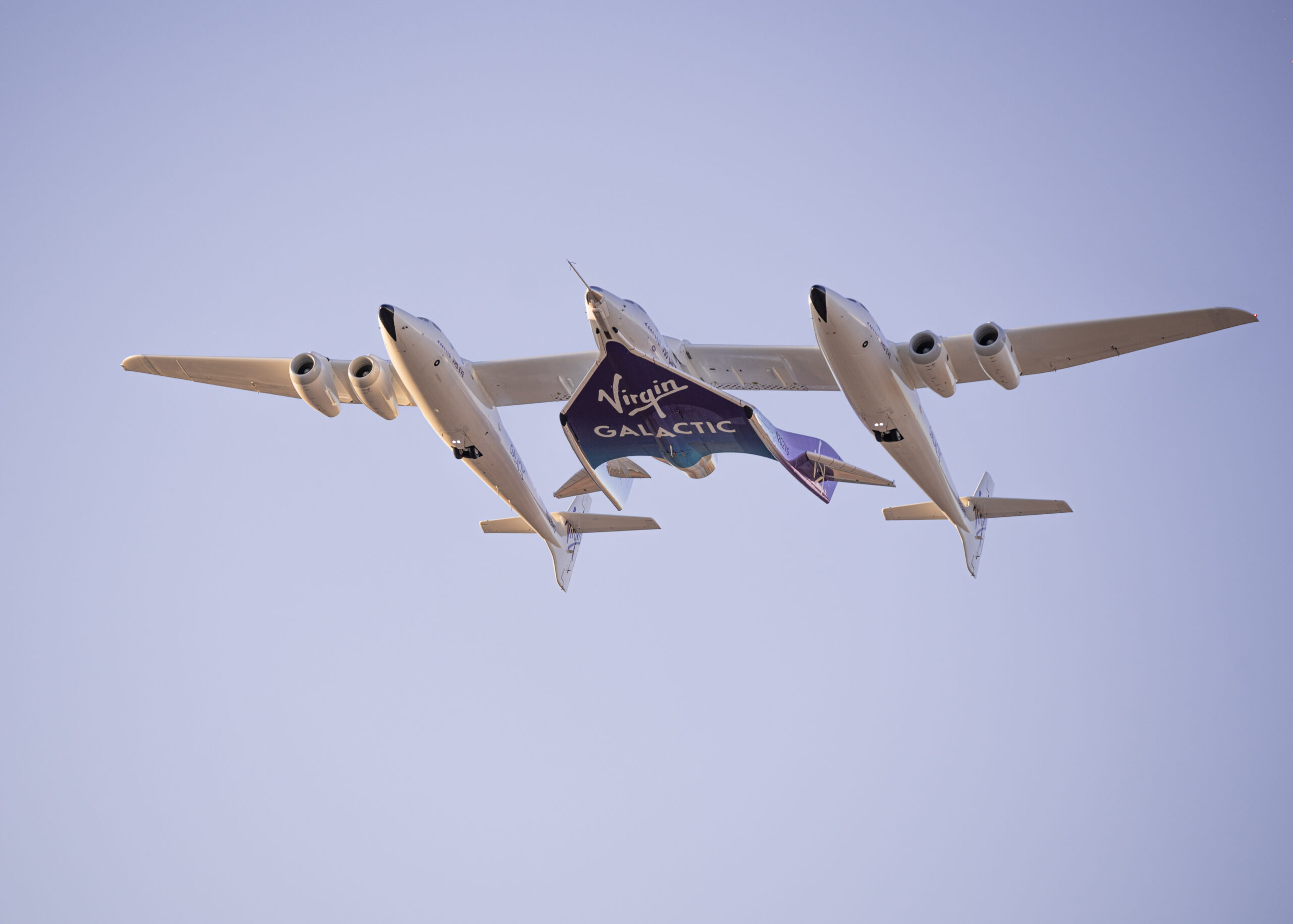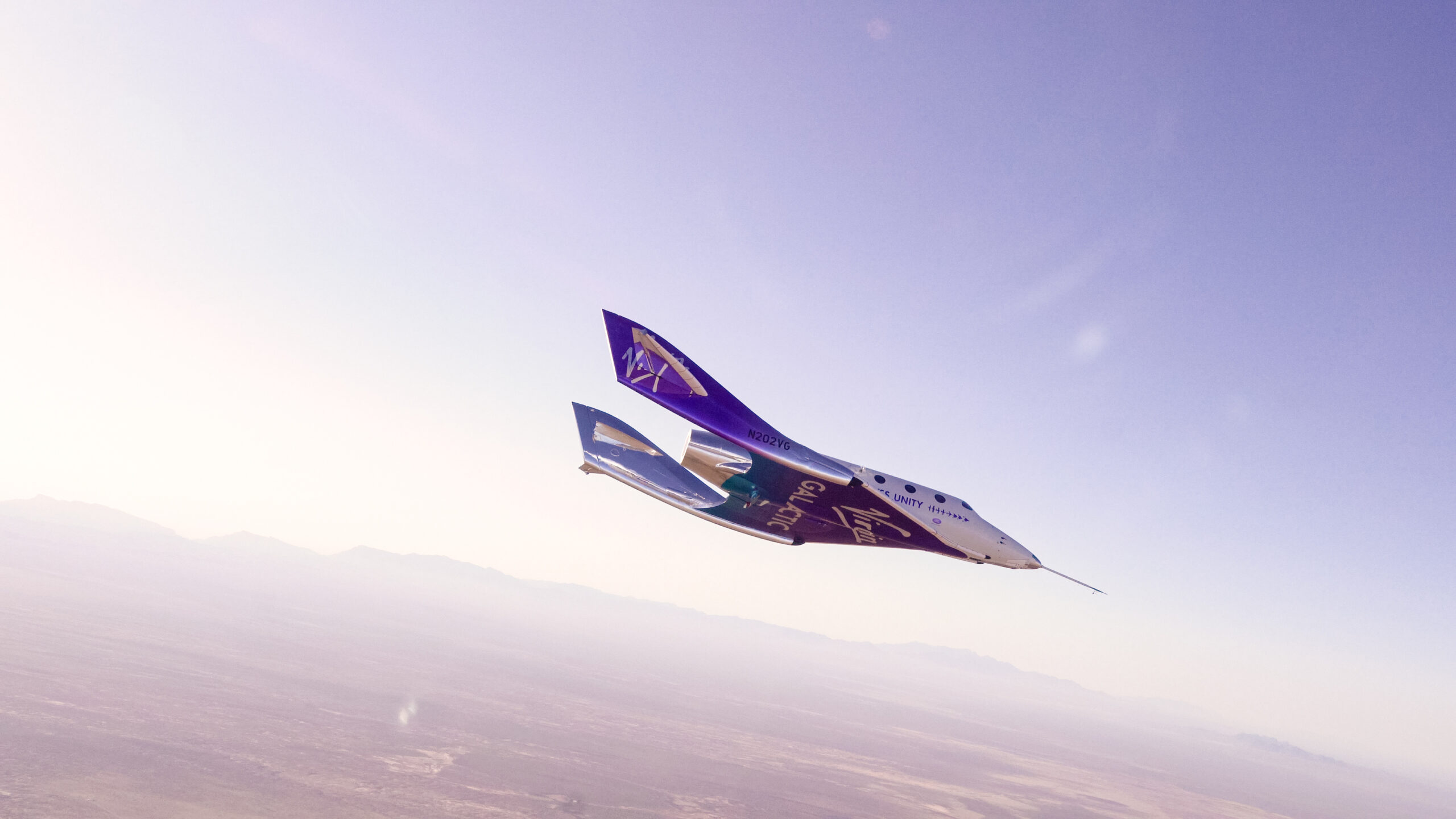Space tourism company Virgin Galactic (NYSE: SPCE), founded by Sir Richard Branson in 2004, achieved a monumental milestone on June 29, 2023, with the launch of its long-awaited first commercial spaceflight, named Galactic 01. This inaugural flight, taking off from Spaceport America in New Mexico, marked the beginning of Virgin Galactic’s incursion into the space tourism industry. There were six passengers aboard — two Virgin Galactic pilots, three members of the Italian Air Force, and a Virgin Galactic trainer. With the ship’s pilot, it marked the most Italians in space simultaneously. In addition, the mission carried 13 research payloads to examine how microgravity affects the human body and other materials.
After a smooth takeoff at 8:30 AM, the VSS Unity rocket ascended to a release altitude of 44,500 feet and reached an impressive apogee of 52.9 miles, breaching the edge of space. The success of Galactic 01 marks a new chapter for the Virgin brand, which has encountered numerous challenges and setbacks in its pursuit of commercial space travel, and elsewhere with its now defunct sister company Virgin Orbit, which filed for Chapter 11 bankruptcy on April 4, 2023, after failing to find funding.
 Galactic 01 take-off from Spaceport, New Mexico. Image courtesy of Virgin Galactic.
Galactic 01 take-off from Spaceport, New Mexico. Image courtesy of Virgin Galactic.An endeavor that underwent delays and setbacks, the launch and completion of Galactic 01 mark a turning point for Virgin Galactic. With a valuation of $1.31 billion, the company’s first commercial flight signifies the realization of its long-standing vision and paves the way for further commercialization. Now that Galactic 01 is successful, the company plans to fly its second mission in August and then aims to begin flying its spacecraft, VSS Unity, once a month.
Looking ahead, Virgin Galactic continues raising capital to develop its upcoming Delta class of spacecraft. The aim is to create a fleet of vehicles capable of regular launches, providing reliable access to space for commercial passengers and researchers.
With an apparent demand for space tourism, Virgin Galactic has a backlog of approximately 800 passengers eagerly waiting for their turn to experience the edge of space. To accommodate this demand, the company reopened ticket sales two years ago, with prices starting at $450,000 per seat, significantly broadening the accessibility of this once-exclusive experience.
 Galactic 01 crew at the edge of Earth. Image courtesy of Virgin Galactic.
Galactic 01 crew at the edge of Earth. Image courtesy of Virgin Galactic.CEO Michael Colglazier expressed his satisfaction with the successful flight, highlighting that this marked their first commercial flight and dedicated commercial research mission, ushering in a new era of repeatable and reliable access to space for private passengers and researchers. They have plans for Galactic 02, their first spaceflight with private astronauts, scheduled for August. They anticipate VSS Unity to continue with monthly space missions while working on scaling their future spaceship to cater to a global audience.
Italian Air Force Colonel Walter Villadei, part of the crew, expressed immense pride in being part of the historic spaceflight. Galactic 01 was Italy’s first commercial suborbital research spaceflight, made possible through a long-lasting collaboration between the Italian Air Force and the National Research Council of Italy.
 Galactic 01 crew at the edge of Earth. Image courtesy of Virgin Galactic.
Galactic 01 crew at the edge of Earth. Image courtesy of Virgin Galactic.“This groundbreaking collaboration propels Italy into the new era of commercial spaceflight as a pathfinder, fostering innovation and paving the way for further technological enhancement in this strategic domain. Together, and in partnership with Virgin Galactic, we have set a precedent for future endeavors and the boundless possibilities that lie ahead,” said Villadei.
Similarly, Virgin Galactic’s VP of Government Affairs, Sirisha Bandla, believes the mission provided “a glimpse” of the potential discoveries that can be made through reliable access to space, furthering scientific knowledge and opening up new horizons for exploration.
 Colonel Walter Villadei during Virgin Galactic’s Galactic 01 spaceflight. Image courtesy of Virgin Galactic.
Colonel Walter Villadei during Virgin Galactic’s Galactic 01 spaceflight. Image courtesy of Virgin Galactic.Beyond space tourism, Virgin Galactic is committed to advancing scientific exploration and collaboration. Their vehicles offer researchers, industries, and governments a platform to conduct experiments, test technologies, and train astronauts in microgravity conditions. The 13 research payloads carried during the Galactic 01 mission cover diverse areas such as biomedical research, thermo-fluid dynamics, and the development of innovative materials,
Each payload had unique objectives and potential applications. Notable experiments include measuring cosmic radiation in the mesosphere to support future deep space missions, testing an innovative evaporator for cold gas propulsion systems in microsatellites, and evaluating cabin air quality for long-duration missions using a nanoparticle monitor. The mission also featured research on shape memory composites for building structures in space and the development of a smart flight suit prototype with integrated sensors for real-time biomedical data collection.
These experiments encompassed diverse areas such as combustion characteristics, material dynamics, health effects, and cognitive conditions in microgravity. Together, they contributed to advancing scientific knowledge and technological advancements, laying the groundwork for future space exploration and enhancing the understanding of human interactions in the unique environment of space.
 Virgin Galactic about to land after its first commercial spaceflight and scientific research mission, the Galactic 01. Image courtesy of Virgin Galactic.
Virgin Galactic about to land after its first commercial spaceflight and scientific research mission, the Galactic 01. Image courtesy of Virgin Galactic.As a historic achievement in space tourism, the successful launch and safe return of the crew and passengers signify the realization of a long-held vision. Considering that Galactic 01 took off just days after the Titan sub disaster, it created added pressure and scrutiny for Branson’s company. Commercial space travel parallels deep sea tourism in many aspects, both involving tight spaces and passengers acknowledging risks through pre-flight waivers. Plenty of social media users pointed out the timing of the crewed flight, but Virgin Galactic went ahead with its plans. With future missions already in the pipeline and a substantial backlog of passengers eagerly awaiting their turn, Virgin Galactic appears to spearhead the future of transformative space travel and experiences.
Subscribe to Our Email Newsletter
Stay up-to-date on all the latest news from the 3D printing industry and receive information and offers from third party vendors.
You May Also Like
3D Printing News Briefs, April 27, 2024: Research, Digital Dentistry, Cycling, & More
We’re starting today’s 3D Printing News Briefs with some research into 3D printed luminescent quantum-dot polymer architectures and free-form laser beam shaping, and then on to an open source 4-axis...
HP & INDO-MIM Collaborate to Boost Metal 3D Printing in India
HP Inc. and INDO-MIM, a US- and India-based supplier of metal injection molding (MIM) powders and contract manufacturer, have announced that the two companies will collaborate to accelerate additive manufacturing...
3D Printing News Briefs, February 17, 2024: Shot Blasting, Service Bureaus, & More
In today’s 3D Printing News Briefs, we’re starting out with post-processing, as SKZ Würzburg is using a shot blast system from AM Solutions for its research. Moving on to business,...
3D Printing News Unpeeled: Not That Kind of Organ 3D Printing
GKN Aerospace will create a 150 jobs in Trollhattan Sweden with an investment of $60 million part of which comes from the Swedish Energy Agency’s Industriklivet initiative. The investment will...






























